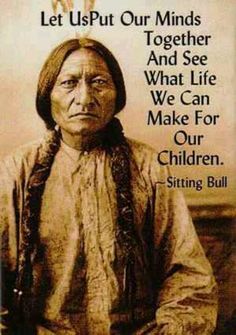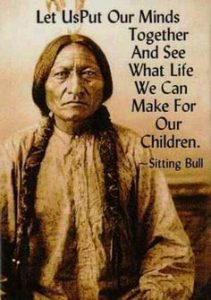THE INDIAN TRUST RESPONSIBILITY: PROTECTING TRIBAL LANDS AND RESOURCES THROUGH CLAIMS OF INJUNCTIVE RELIEF AGAINST FEDERAL AGENCIES…
*Mary Christina Wood*
I.
Enforcement of the federal trust responsibility’ is necessary to protect Native America from environmental assault. Traditional lifeways that reach back literally thousands of years are poised in jeopardy along with the natural resources upon which they depend. Across Indian country, many tribes are at the brink of losing their fish and wildlife resources, having their land and water supplies contaminated, or having their sacred sites destroyed forever. At least 317 reservations in the United States are “threatened by environmental hazards., 2 For example, the Confederated Colville Tribes of Washington, the Chippewas of Wisconsin, the Gros Ventre and Assiniboine Tribes of Montana, and several others battle massive mining projects just off reservation boundaries.3 The Northern Cheyenne Tribe deals with impacts from five coal strip mines, a 2,000- megawatt power plant, and potentially 16,000 new coal methane wells off its reservation. The Pyramid Lake Band of Paiutes and the Klamath, Yakama, Spokane, Salish, and Kootenai Tribes struggle to reclaim enough water in the rivers to sustain their fisheries.’ The Western Shoshones in Nevada confront a proposed nuclear waste dump, as well as. the existing fallout from nuclear waste testing on their aboriginal lands.6 The fishing tribes of the Columbia River Basin urge changes in hydrosystem operations to prevent the salmon species they have relied on for nearly 10,000 years from becoming extinct.7 The Hopi, Navajo, Sioux, Pueblo, Paiute, Quechan, Blackfeet, Wintu, Zuni, and perhaps dozens of other tribes now fight to protect their sacred sites from desecration. 8 These threats to Indian country are pervasive, and the potential damage is permanent.
In the treaty era, the government promised homelands that could sustain tribal lifeways, governments, and economies. But much of the natural web that supports tribal life and culture occurs beyond the boundaries of Indian country. These lands contain species that tribes hunt and fish for, roots and berries that they gather, headwaters and tributaries that flow into their reservation streams, and sacred sites. These are being destroyed at an unprecedented pace, and the pressure from industrial America is both unyielding and unbounded, coming from corporations that feed on growth. While environmental disease may sooner or later affect everyone in the United States, the impacts on Indian country are magnified, because the land base is the linchpin for tribal survival. The trust responsibility should play a role in protecting tribal lands and resources, but the trust doctrine stands in potential jeopardy today as courts collapse protective trust requirements into statutory standards.
II.
Jerry Meninick, a member of the Yakama Nation, once said in testimony before Congress: “My ancestor.., who signed the treaty.., accepted the word of the United States-that this treaty would protect not only the Indian way of life for those then living, but also for all generations yet unborn.” 9 His words capture a fundamental premise-the duty of protection-that forms the background of every relinquishment of native property, whether accomplished by treaty, statute or executive order.’0 In exchange for receiving Indian lands, the government would protect tribes on their retained lands, or reservations, and in some cases would extend protection to traditional uses on off-reservation lands. For example, in 1854-1855, when the federal government negotiated treaties with the fishing tribes of the Pacific Northwest,1 ‘ the tribes agreed to cede the majority of their lands only in exchange for assurances that their fishing rights in these areas would be protected. – The government promised this, and on this promise, the tribes of the Pacific Northwest ceded 64 million acres of land to the federal government. 3 Across the country, native reliance on such federal promises of protection was manifest and gave rise to a sovereign trust for the benefit of all tribes. 4 The question is whether these federal promises endure to meaningfully protect tribal resources today.
Certainly the promise of protection is tested by modem industrial society. In the Columbia River Basin, for example, just after treaties were signed, an unprecedented -human assault began on the natural resources that supported life throughout the basin. Non-Indians commercially over-fished the salmon.”
Mary Wood goes on deeper to bring forth more evidence that the states do not carry nor do they hold jurisdiction over any Indian Tribes as stated by the BIA Source
What is the federal Indian trust responsibility?
The federal Indian trust responsibility is a legal obligation under which the United States “has charged itself with moral obligations of the highest responsibility and trust” toward Indian tribes (Seminole Nation v. United States, 1942). This obligation was first discussed by Chief Justice John Marshall in Cherokee Nation v. Georgia(1831). Over the years, the trust doctrine has been at the center of numerous other Supreme Court cases, thus making it one of the most important principles in federal Indian law.
The federal Indian trust responsibility is also a legally enforceable fiduciary obligation on the part of the United States to protect tribal treaty rights, lands, assets, and resources, as well as a duty to carry out the mandates of federal law with respect to American Indian and Alaska Native tribes and villages. In several cases discussing the trust responsibility, the Supreme Court has used language suggesting that it entails legal duties, moral obligations, and the fulfillment of understandings and expectations that have arisen over the entire course of the relationship between the United States and the federally recognized tribes.

